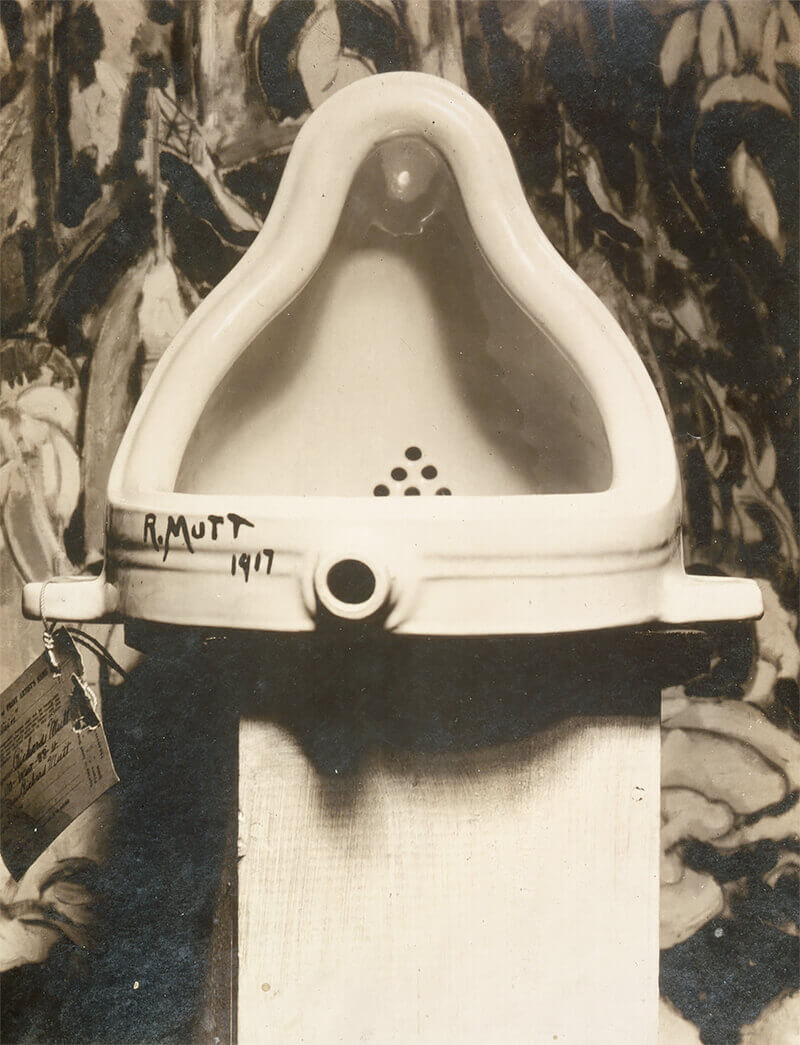Surrealism is an intellectual and artistic movement created after WWI, in reaction to the horror and absurdity of the war largely influenced by the Dada movement (1916-1924) which produced works of anti-art that deliberately defied reason.
Dadaism
The Dada movement, also called Dadaism, is an intellectual and artistic movement born in 1916 in Zurich under the collective impetus of several nonconformist artists and writers including Hugo Ball (director), Emmy Hennings (dancer, poet, writer), Tristan Tzara (poet and writer), Richard Huelsenbeck (poet), Jean Arp (sculptor), Hans Richter (painter).
They had set themselves the goal of breaking the rules that artists had formely imposed on themselves in literature and art, by advocating freedom of creation in all its forms, the absurd to the point of self-destruction, often with lots of humor. The aim was to create scandals and shock the bourgeoisie, in other words to provoke.
The movement became international and many artists joined it. Among them, Marcel Duchamp,
Man Ray, Francis Picabia and André Breton. The movement ended in the 20s opening the door for the surrealists.
Marcel Duchamp, Fountain, 1917; photograph by
Alfred Stieglitz, at the 291 (Art Gallery) following the 1917 Society of Independent Artists exhibit.
Birth of the Mouvement
Surrealism was born in Paris in a post-war context when men sought at all costs to escape the horrors of war and death. Art became a way to escape harsh realities. Technical innovations and improvements also became a vector for the transformation of artistic production, thus giving artists new tools of expressions. Artists wanted to be revolutionary and innovative.
In the continuity of the Dada movement (for its spirit of revolt), former Dadaists like André Breton and Man Ray continued their artistic reflection. Aragon, Ernst, Soupault and Apollinaire joined them to develop new forms of expression. Surrealism is not a school, but a new direction of thought, an artistic movement. It’s a concept and a way of doing things. The surrealists advocate the lack of control over images and the importance of research to lead to the surreal. Unconsciousness, dream, automatism, imagination are the basic concepts of the surrealist movement.
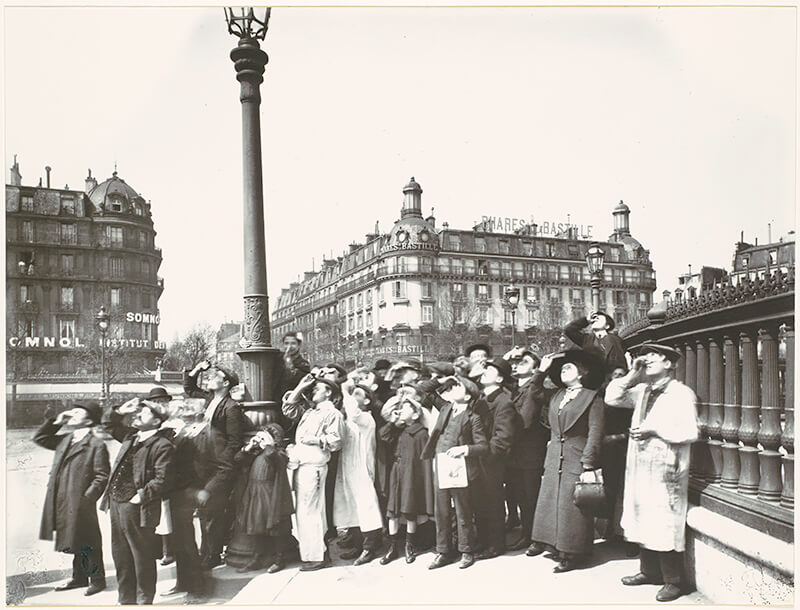
L'Eclipse - Avril 1912, Eugène Atget, 1923- 24, France, CCO Metropolitan Museum of Art
Source: V&A Museum
First Manifesto of Surrealism
The word ‘surrealist’ (suggesting ‘beyond reality’) is created by the French poet Guillaume Apollinaire in the preface of a play performed in 1917. But it is André Breton, that defined it.
André Breton is a French poet, writer and essayist considered to be the leader of the surrealist movement. In 1924, he published the
Premier Manifeste du Surréalisme (First Manifesto of Surrealism) in a preface to his poetry book
Poisson Soluble where he wrote this definition of surrealism:
"
pure psychic automatism, by which one proposes to express, either verbally, in writing, or by any other manner, the real functioning of thought. Dictation of thought in the absence of all control exercised by reason, outside of all aesthetic and moral preoccupation."
In 1930, André Breton published a
Second Manifeste du Surréalisme in which he recalled the principles of surrealism and took the opportunity to criticize those deviating from the movement.
Surrealism was born from a collective thought, from the assembly and reflections of several artists, whether they were painters, poets, writers... Louis Aragon, André Breton, Paul Éluard, Benjamin, Péret, Salvador Dali , Guillaume Apollinaire, Man Ray, Hans Bellmer... where amongst them. It was a joint endeavor, not an individual one, because a single artist would then become the victim of his own subjectivity.
They met in cafes or at André Breton’s home in Paris. Together, they lead artistic experiments: literary, pictorial, photographic. They questioned language and realism, challenged their point of view and seek art in dreams and in the human unconscious.
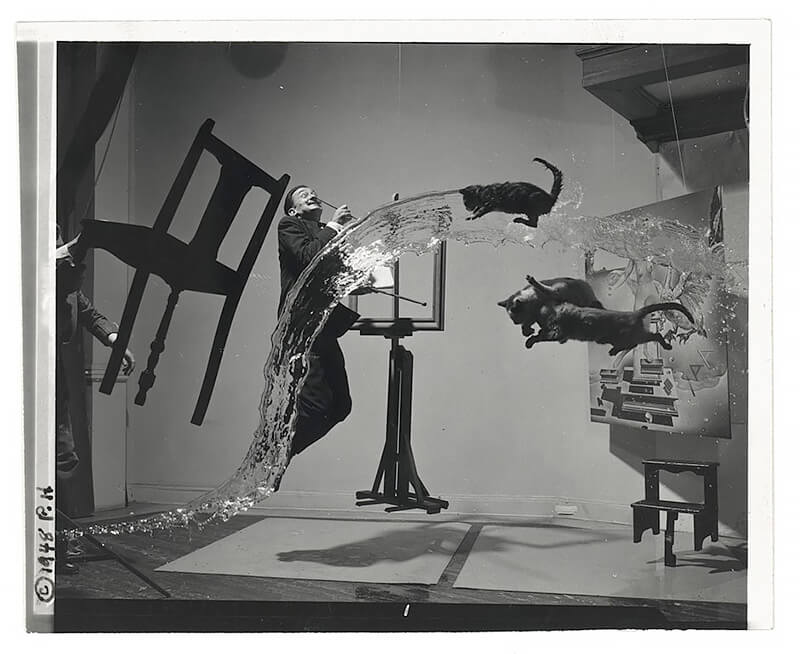
Salvador Dali A (1948) © Philippe Halsman, Library of Congress
Source: Wikipedia
The Project
Together, the surrealists led important reflections on different forms of artistic expression. The goal was to send a message, to change things and to focus only on aesthetics. Surrealism was a revolutionary movement with active members and their ideas were revealed in their work.
New Language
Surrealist moved away from conventions in both form and intention, creating free-form expressions. Paul Éluard, one of the leading surrealist poets, insisted on a new language that could create new modes of perception and liberate the mind. Such liberation would take a myriad of forms. Robert Desnos, for example used automatic writing and frequently worked under hypnosis to further free his mind from the bounds of constrained consciousness.
Surreal
The exploration of the unconscious was one of the goals of the surrealists. Imagination according to the surrealists will make it possible to join surreality. Dreams are important for surrealists, as a direct access to the unconscious. They try to recreate their dreams, to write them down, because dreaming is a form of pure creation without the control of the mind.
The unexpected and the uncanny as well as fantasy are important in the surrealist's mind.
They consider madness as a surrealist mode of expression in the sense that the madman creates his own universe and his mind enjoys absolute freedom. Surrealists would almost praise it, as well as paranoia.
Finally, love transcends all of these themes and patterns. Eroticism, passion, women are for them a means to reach the ideal and to go beyond all limits. Love breaks taboos and is therefore revolutionary. It holds a liberating force and is a colossal source of inspiration, including through the mythical images of woman that the artists create in their own work.
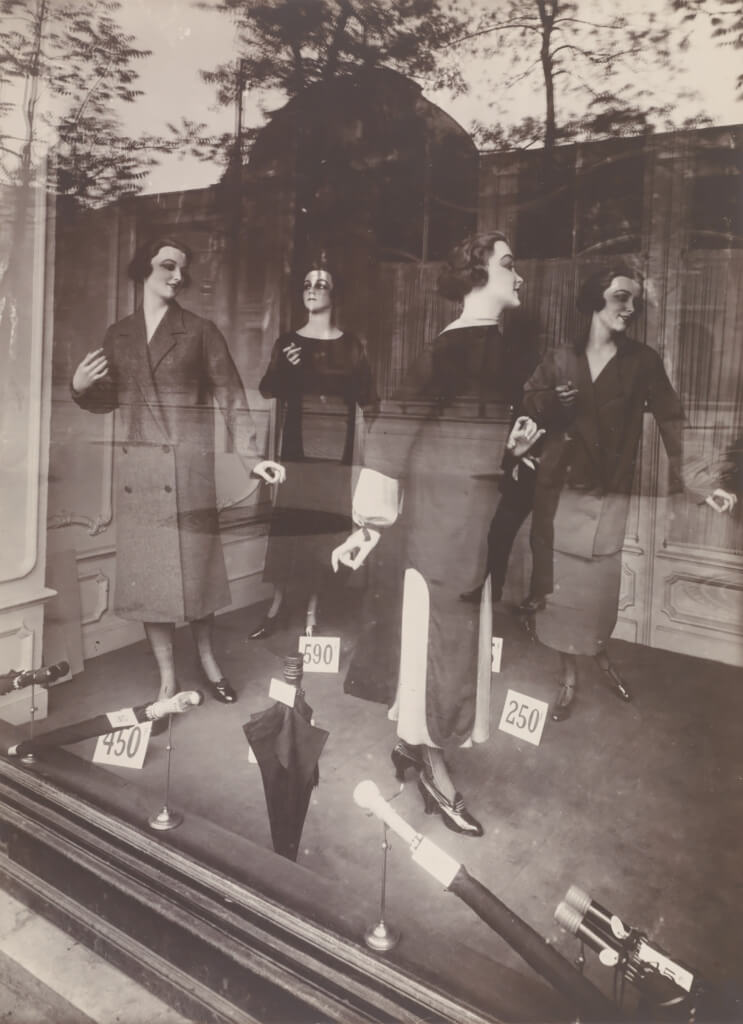
Storefront, avenue des Gobelins 1925 © Eugène Atget, J. Paul Getty Museum
Source: The Art Story
The specificity of photography within the surrealist movement
Photography is an art that holds a special place within the surrealist movement. It is omnipresent in its various activities and achievements, it accompanies all publications (books, magazines). Photographs influence their texts and games, it is familiar to them. Nevertheless this art remains absent from the discourse, one does not find theoretical literature on photography as one finds on painting, drawing, poetry... The result is that the works are very diverse.
A common identity
Through photography, the surrealists have held together and built their common identity by playing on the codes of group portraits. They took pictures together, showed their unity. The strength of the surrealist movement lies in its collective action and photography was a way of immortalizing it. We find ourselves faced with popular modes of representation of the 'family'
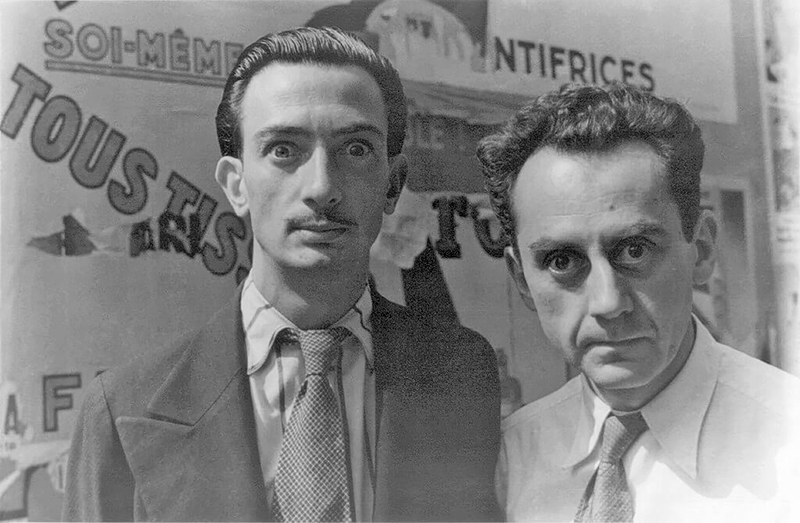
Portrait of Man Ray and Salvador Dali, Paris 1934 © Carl Van Vechten (1880-1964)
The surrealists question the documentary value of photography. They perceive its capacity to capture the manifestations of the marvelous that can happen at random. On the one hand, they will seek to capture the spontaneous, the unexpected, like with the photo booths they compare to automatic writing. On the other hand, they stage situations and then photograph them, sometimes reworking the image after the shot was taken. Photography is what has been, but it is also deceptive. The devices capture images that the eye cannot perceive, the image can be deceived by technical means and photography is then an illusion.
Sample image: Père Ubu 1936 by Dora Maar
The Surrealist artist Dora Maar is better known as Picasso's dark-haired model and companion in the late 1930s than for her astonishing works. Her incarnation of the bestial nature of man is titled after the infamous and absurd dictatorial antihero of Alfred Jarry's play Ubu Roi (1896). Maar's imaginative evocation of the pear-shaped, breast-plated Ubu in the monstrous reality of a baby armadillo is one of the most compelling and repellent of Surrealist photographs.
Source: The Met
Mixed Media
The surrealists integrate photography into their plastic creations. This is particularly true in the collages and 'cadavres exquis' (exquisite corpses or exquisite cadaver) they made in groups. In these specific cases, photography is not the only medium used and it is only a material to construct a work, associated with other techniques such as drawing, writing or other materials such as paper. newspaper, prints, letters...
Experiments
Some surrealists like Man Ray studied photographic techniques, to master them in order to achieve unique, controlled or totally fortuitous works. Thanks to technical progress, the possibilities are endless.
Used techniques
In terms of photographic technique, the surrealists tried to use it to capture light. Some effects were totally mastered others completely circumstantial. They would stage their subjects or manipulate the images during the printing process so as to transform (in a controlled or uncontrolled way) the final image.
There are two kinds of surrealist photographs, the one that depends on technical manipulation and the one that comes from research. We can also speak of controlled or spontaneous photographs.
Because of the numerous experiments of photographers there is a partial abandon of the camera. For some it is even unproductive for creation. The device cannot lie, this goes against the fact that photography must be somewhat reminiscent of dreams.
The surrealists simply remind us, that the word 'photography' means:
to write with light. In other words for some the gear is redundant.
Unreflective/spontaneous/circumstantial photography is part of our perception, of automatism (what we perceive immediately without any thinking). In other words techniques such as photograms, burning, space writting...
Reflective/controlled/deliberate photography is part of the representation of our perception. Whether the images are manipulated or not, in the design, in the darkroom or later. It includes, simple images, images that were not manipulated but which 'sculpt' the subjects, negative prints, solarization, double exposures, fossilizations, photomontage, collage, manipulation with mirrors, framing.
The photogram or Rayograph
This process allows you to get an image without using a camera. Objects are placed on a photosensitive surface to expose it to light. In the case of Man Ray's photographs, we speak of a rayographs which he himself defines as:
a photograph obtained by simply interposing the object between the sensitive paper and the light source. Seized during moments of visual detachment, during periods of emotional contact, these images are the oxidations of residues, fixed by light and chemistry, of living organisms .
Brûlage (burning)
Developed by Raoul Ubac and David Hare, this process consists of 'attacking' the emulsion of the negative with heat, the result of which melts, waves and distorts the image. This then gives a 'cloud' effect on the final image.
While, in surrealism, the classic automatic image processes of frottage, decalcomania, cadavre exquis, among others, served to elevate suggestive, previously unseen worlds of forms out of formlessness with the aid of the spontaneity of matter (of colours, water, textures, etc.) or by accident, Ubac’s intention using brûlage was to liquefy forms that had solidified into unconsciousness and to transfer the optical projection of reality, which had been etched with silver salts into the photosensitive layer, into a precrystalline, smudgy, magma- or fire-like state. - Herbert Molderings, 1996
Burning facilitates random deformations, which can appear to be phantasmagorical.
Sample image: La Nébuleuse 1939 by Raoul Ubac
Light Writting
Light writing is when you use a long shutter speed and use a light source to 'write' or make patterns or drawings in your photo.
This process involves using a long exposure time in a dark environment by moving a light source there or moving the camera. We then find on the photograph the traces of the movement of the light.
Sample image: 'Space Writing (Self-Portrait), 1935 by Man Ray
Man Ray drew with a penlight in space and captured a tangled skein of lines by lengthening his film’s exposure time. The camera fixates an ephemeral gesture, thus hinting at the unseen reality art might disclose. While the photograph leaves the artist’s face obscure, the portrait reveals its maker’s presence through writing. Man Ray’s signature appears backwards, as if to emphasize the challenge of understanding what we see. The print bespeaks the artist’s adventurous approach to photography, a word that literally means “light writing.” Punning on the term’s etymology, the artist playfully yet deliberately “photo-graphs” himself, allowing his face and body to disappear behind the name that would survive him.
Source: Bowdoin College Museum of Art
Solarization or the Sabatier Effect
Solarization and Sabattier effectare quite distinct effects.
The term solarization in photography is used to describe the effect of tone reversal observed in cases of extreme overexposure of the photographic film in the camera. Most likely, the effect was first observed in scenery photographs including the sun. The sun, instead of being the whitest spot in the image, turned black or grey.
The Sabattier effect, also known as pseudo-solarization (or pseudo-solarisation), is a phenomenon in photography in which the image recorded on a negative or on a photographic print is wholly or partially reversed in tone. Dark areas appear light or light areas appear dark.
Double exposure
This technique prints two images on top of each other. We take a first photo and then take a second on the same negative, thus ending up with two superimposed images. For the surrealists, it was the way to show in one place, two different states.
Sample image: Composition 1929 by Maurice Tabar
This photograph is informed by the artist's experiences as an advertising photographer, X-ray technician, and assistant to Man Ray. By printing through a sandwich of several negatives, Tabard fabricated a nude that inhabits no definable space or time. She is at once Pygmalion's Galatea or Botticelli's Venus while remaining a Parisian model who has just stripped off her stockings. For the Surrealists, the female form was the subject of endless, obsessive reworkings.
Source: The Met
Combination printing
Combination printing is the photographic technique of using the negatives of two or more images in conjunction with one another to create a single image. The concept of combination printing stemmed from the desire to create more of a fine art within photography and often more idealized images. The technique was also used to create new, original compositions and provided new ways for photographers to be more creative with their work. It was the technique used before photomontage.
Photomontage
Photomontage is the process and the result of making a composite photograph by cutting, gluing, rearranging and overlapping two or more photographs into a new image. Sometimes the resulting composite image is photographed so that the final image may appear as a seamless physical print. Even though the surrealists made many collages, they preferred double exposures.
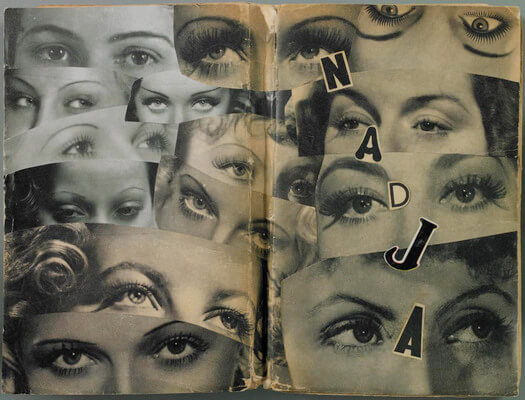
Cover of the 1928 Gallimard edition of Nadja by André Breton, collaged over by Marcel Mariën, 1938.
By using a negative that is moved slightly, we obtain an offset which gives relief to the photograph as well as depth.
Distortion
André Kertesz worked on the reflection of distorting mirrors (the series of distortions). He was not part of the surrealist movement, but his images were done in a surreal spirit.
Sample image: Distortion #51, 1933 by André Kertesz
Although Kertesz had long been interested in mirrors, reflections, and the idea of distorting the human figure, he did not seriously investigate their photographic possibilities until 1933, when the risqué French magazine Le Sourire commissioned him to make a series of figure studies. Using a funhouse mirror from a Parisian amusement park, Kertesz, who had never photographed nudes before, spent four weeks making about two hundred negatives. A handful of these Distortions, including this one, are compellingly surreal and unnerving--not unlike Munch's famous painting The Scream of 1893 (National Gallery, Oslo).
Source: The Met
Rotation
The surrealists use previous techniques or invent new ones in order to transform photography in an innovative way and in accordance with their project. The idea is to seek to show the unreal, the dream, to capture images that force the imagination, to show what the human eye cannot perceive.
What Happened to Surrealism?
According to Jean-Paul Sartre, the surrealists' project was not only too ambitious, but too idealistic. Artists who sought to escape constraints, ended up imposing new ones on themselves. They wanted to destroy conscious life by using automatism but they ended up creating real works. They gave themselves a clear conscience, but remained bourgeois. According to Albert Camus, they were even false Marxists.
Utopian, the surrealist project no longer met what most artists and the public expected. Little by little, the group broke up, especially because of the tensions between the different artists. The death of André Breton truly initiated the end of surrealism in 1966, although it had been out of date for a long time and other art movements and schools had already taken the center stage.
Nevertheless, Surrealism leaves a legacy and subsequently influenced writers, painters, poets. For example Boris Vian, in his books
L’écume des jours (Froth on the Daydream ) and
L’arrache-coeur (Heartsnatcher) comes close to the surrealist project as well as all the talented photographers who have been inspired by the movement since then.


